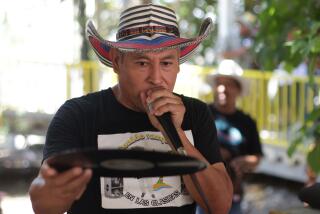When Ruben Alcala came home from serving...
- Share via
When Ruben Alcala came home from serving in World War II, he returned to Colonia Juarez, a Latino enclave in an area that later became part of Fountain Valley. He married his girlfriend, Connie, after getting his old job back as a ranch hand for C.J. Segerstrom. He built their first home himself, not far from where his parents lived.
The colonia residents kept to themselves, raising their children in a family-oriented atmosphere centered around the Holy Family Mission Catholic Church on Ward Street, where a Mexican-American priest said Mass in Spanish on Sundays. Families grew their own corn, and some raised chickens and goats. “Everyone knew everyone else,” said Connie Alcala.
The neighborhood retained its identity, even after it became surrounded by modern subdivisions during the building boom in the 1960s. But compared to the newer neighborhoods, many of the original homes in the colonia, built in the 1920s, were substandard. The neighborhood lacked basic amenities such as street lights and sidewalks. It became stranded in time while Fountain Valley grew up around it. Walls were constructed between the 40-acre colonia and nearby housing developments, creating resentment among colonia residents. Youths scrawled graffiti on the offending barriers.
But as a part of the federal War on Poverty, residents teamed up with local officials in 1968 on a neighborhood improvement campaign. Colonia Juarez residents helped pay for the installation of street lights and a federal grant provided new waterlines and a sewer system. The neighborhood’s rutted streets were resurfaced. The Alcalas gave up a portion of their property so an alleyway could be built.
In 1975, muralist Sergio O’Cadiz was commissioned to paint a mural depicting Mexican history on the walls separating Colonia Juarez from its neighbors. “That solved the graffiti problem,” said Fountain Valley City Councilman Jim Neal, who was then the city manager.
Today, the brightly painted mural and the Holy Family Mission Catholic Church are the most visible reminders of Colonia Juarez, which is quickly becoming one of Fountain Valley’s most upscale neighborhoods. For many, property ownership in the former barrio became the key to the American Dream. When property values skyrocketed in the late 1970s and early 1980s, many families sold their homes, built on double-sized lots, at a profit and moved on. Many of the original homes have been razed to make room for large, elegant houses.
But there are still many Latino families in Colonia Juarez, most of them descendants of the original settlers. The mailboxes on Calle Madero Street bear the names Basques, Elizondo, Madero, Sanchez, Barudos and Chavez.
The Alcalas still live in the colonia on Avenida Cinco de Mayo. Their daughter, Lydia, who was the first Miss Fountain Valley, is married and lives next door. Like many of the original Latino families who remain, the Alcalas have constructed a new home in place of the original built in the 1940s. Other families live as they have for years, in small wooden homes with corn growing in the front yard.
“We’re happy with the way things have changed,” said Ruben Alcala, who served on the Fountain Valley Planning Commission for 12 years. “Some of the nicest homes in the city are located here now.”
Not far from Colonia Juarez is the Fountain Valley Civic Center, where a $1.3-million expansion of City Hall is scheduled for completion in December, about the same time a new $2.2-million library is scheduled to open nearby.
The Civic Center is also home to Heritage Park, which houses the last remaining structures of the original Talbert Village, including a real estate office built by city founder Tom Talbert, who once owned most of what is now Fountain Valley.
Population Total: (1990 est.) 7,305 1980-90 change: +2.6% Median Age: 34.2
Racial/ethnic mix: White (non-Latino), 73%; Latino, 11%; Black, 1%; Other, 15%
By sex and age: MALES Median age: 34.5 years FEMALES Median age: 34.0 years
Income Per capita: $22,505 Median household: $46,275 Average household: $53,266
Income Distribution: Less than $25,000: 16% $25,000-49,999: 39% $50,000-74,999: 25% $75,000-$99,999: 13% $100,000 and more: 7%
More to Read
Sign up for Essential California
The most important California stories and recommendations in your inbox every morning.
You may occasionally receive promotional content from the Los Angeles Times.










